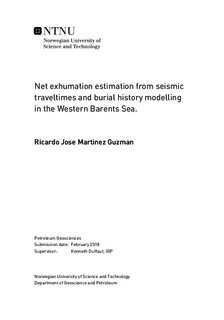Net exhumation estimation from seismic traveltimes and burial history modelling in the Western Barents Sea.
Master thesis
Permanent lenke
http://hdl.handle.net/11250/2492144Utgivelsesdato
2018Metadata
Vis full innførselSamlinger
Sammendrag
A new seismically based technique is proposed for the estimation of net exhumationmagnitudes in sedimentary basin areas. The method uses traveltimes mapped from welllog data or pre-stack seismic data, starting from the seabed, on a reference area with onlysubsidence, and from an area suspected to be uplifted. The method is compaction-based,and allows for estimating net exhumation magnitudes at areas where severe uplift anderosion prevent the usage of the shale compaction depth-trend technique. The techniqueconsiders the similarity between the stratigraphic sequences from reference and upliftedareas in terms of their NMO parameters and velocity heterogeneity. Linear P-wave velocityfunctions are then estimated for both areas using dix-type mathematical relations,and compared in a depth dependent scheme. Three sets of net exhumation magnitudeswere estimated by applying the method in nine wells spread across the Western BarentsSea. The net exhumation magnitudes increases from the west and southwest where minoror no uplift is predicted, towards the East and North-East, where exhumation magnitudesbetween 800 m and 1700 m are estimated. Compared to the shale compaction technique,the method is considered to be less affected by abnormal pore pressure development. Theestimates are in agreement with published net uplift magnitudes derived from shale compactionand thermal maturity techniques, petrographical and sedimentological analysis,etc. The net exhumation magnitudes were further used in the construction of burial historycurves for simulating mechanical and chemical compaction in clean sandstones. Themodelling scheme successfully predicts the quartz cement volumes quantified in petrographicanalysis, and the porosity, rock moduli, and velocities measured by wireline welllogging. The P-wave velocity proved to be the property least affected by factors outsidethe model. The property modelling appeared to be most sensitive to the maximum temperaturesachieved according to the net exhumation magnitudes. Further empirical evidenceregarding the quality of the net uplift estimates is provided by positive correlation of theexhumation estimates with present-day differential stress profiles. Moreover, the velocityof exhumation-corrected Barents Sea sandstones is in agreement with published mechanicaland chemical compaction velocity depth trends, derived for unexhumed sandstonesfrom the Norwegian and North Sea.
